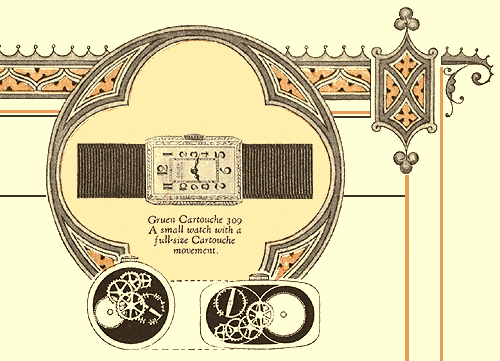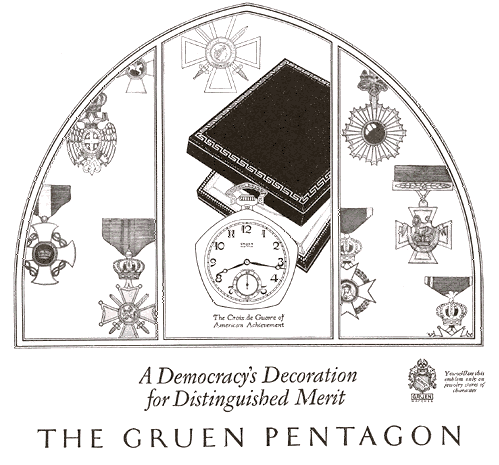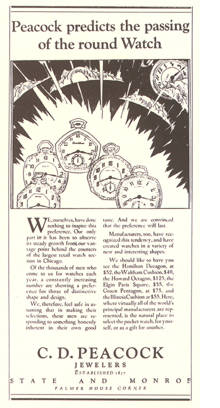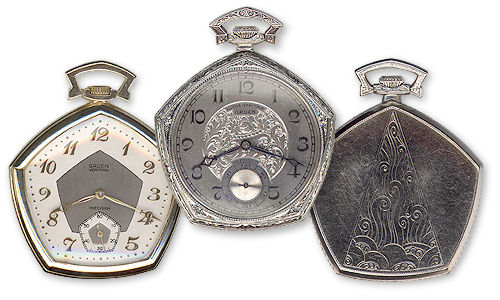|
1921: The Cartouche "the logical wrist watch shape" | |
|
Above: An illustration from Gruen's 1929 catalog. The diagram compares the round movement used in all other women's wristwatches with the Cartouche. The caption reads, "Note that although the Cartouche appears much smaller and more attractive, the wheels and parts are actually larger because the movement fills out the entire case space." Wristwatch popularity began to steadily rise in the 1920s, especially among women. Fashion quickly moved away from the early 'pocket-watch-on-a-strap' look—the tonneau (barrel) and rectangle became popular. Thinking it was not worth the effort and expense to design and build special wristwatch movements, most companies used the small, round movements made for women's pocket watches. Putting a round movement into a long, rectangular case meant that most of the interior volume of the watch was wasted. Gruen's first movement designed specifically for wristwatches was the Cartouche, released in 1921 and used in a line of elegant women's watches. The Cartouche name comes from its shape—a long rectangle with rounded ends. Because it fills the case, the Cartouche was able to use larger and sturdier parts, and was more accurate and reliable than the smaller round movements would have been. The Cartouche also allowed Gruen to offer sleeker watch designs, since the case didn't have to disguise the bulge of a round movement inside. Most women's wristwatches from the 1920s were worn on silk ribbons, as shown above. Later, in the 1930s, many owners changed these to chains or bracelets as the ribbons went out of fashion. The Cartouche was popular and successful—Gruen made over 500 different Cartouche models. Most of Gruen's competitors would not start designing true wristwatch movements for several more years. | |
|
1922: The Pentagon "the Croix de Guerre of American achievement" | |
|
Gruen's most distinctive pocket watch case was the Pentagon. Even if it is fully adjusted, a watch will run much more consistently if it stays predominantly in one position. The flat bottom of the Pentagon kept it sitting upright in the wearer's pocket. Round watches tended to turn sideways, because of the weight of the crown and bow at the top. Ads proclaimed that the Pentagon was the "watch that won't tip over in your pocket."
Perhaps more important than the technical reasons for the shape were its attractiveness, distinctivess and the fact that it was protected by one of Fred Gruen's design patents. No other company could make a five-sided watch, so a Pentagon would be easily recognized as a Gruen even from a distance. The watch fit in well with current trends; pocket watch cases had been getting more eccentric for several years. The Pentagons were not just an ordinary Gruen watch mounted in a shaped case. They made up their own distinct, very upscale model line. The 1929 catalog, far from lumping them into the pocket watch section, gives the Pentagon its own section equal to the pocket watch section. All Pentagons have Precision-grade (or higher) and VeriThin (or thinner) movements. There were no cheap models; prices for a normal round VeriThin started at $50 USD (around $1275 USD today ), but the cheapest Pentagon model was $75 USD ($1875 USD today). $75 was only the starting price; upgrading the case or movement could raise the final cost considerably.
Above: A graphic from Gruen's 1929 catalog, showing some of the case shapes they had used for pocket watches. During the 1920s, wristwatches were rapidly rising in popularity for every-day use, while pocket watches were increasingly becoming specialized as a formal-dress accessory. Below: A selection of Gruen pocket watch shapes. The watch on the upper left (with gold hands and dial numbers) is in a Triad case, and is a SemiThin. All of the others are VeriThin models.
The company encouraged customers to pick the Pentagon as a presentation watch, and ran numerous ads promoting this concept. There was even a Pentagon kit available for the presenter, containing a helpful book outlining the suggested ceremony. Ads listed prominent men who owned or had been awarded a Pentagon, and the company generally tried to create an aura of prestige and exclusivity around them. Gruen constantly referred to this watch as the "Croix de Guerre of American achievement." The idea was that the Pentagon should be a badge of honor for a man in civilian life, much as a medal would be to a soldier. Croix de Guerre("war cross") refers to a military decoration.
The 1920s were the last great decade for pocket watches. When he introduced men's wristwatches to America in 1908, Fred Gruen had eventually been forced to make deals and "dump" many of them. Now, in the early 1920s, wristwatches were on their way to dominating the market. When the Pentagon made its debut in 1922, pocket watches still lead in popularity, but the upstart wristwatches overtook them in 1927 and had left them far behind by the early 1930s. The pocket watch would linger, however. It would still be a while before it was acceptable to wear a wristwatch instead of a pocket watch with a tuxedo, and pocket watches would continue to be used for special presentations. Below: A trio of Pentagons. Left, a 14k yellow gold Ultra-VeriThin. Although the dial is marked VeriThin, this watch has an Ultra-VeriThin case and movement. Note how the dial shape and its decorative center section, the seconds subdial and even the bow (the attachment for the watch chain) all echo the case's five-sided shape. Center, another Ultra-VeriThin, this one in white 14k gold. Both models were priced in the $150 range (about $3750 today). Right, the back of a reinforced white gold VeriThin with a 17-jewel V4 movement, showing one of the standard engraved case backs that were available. Since these watches were often used for special presentations, many of them were ordered with plain backs, in order to receive personalized engraving.
next: the Fiftieth Anniversary pocket watch >>
[ 1867 | 1894 | 1904 | 1917 | 1921 | 1922 | 1929 | 1940 ] [ Contents | Intro | Sources | Links | FAQ | Patent | Cover ]
Copyright © 1999-2001 Paul Schliesser contact
| |


 Right: A Pentagon reinforced green gold model from the 1920s, with a V4 VeriThin movement.
Right: A Pentagon reinforced green gold model from the 1920s, with a V4 VeriThin movement.


 Left: A 1920s ad by C.D. Peacock, a large Chicago jeweler, predicting the demise of the round pocket watch and suggesting some alternatives that they'd be happy to sell you. The ad includes the Hamilton Decagon ($52), the Waltham Cushion ($40), the Howard Octagon ($125), the Elgin Paris Square ($35), the Gruen Pentagon ($75) and the Illinois Cushion ($55). The 1920s were a period of playful experimentation with pocket watch designs. Except for the Pentagon, most of these companies, including Gruen, had made pocket watches in all of these shapes.
Left: A 1920s ad by C.D. Peacock, a large Chicago jeweler, predicting the demise of the round pocket watch and suggesting some alternatives that they'd be happy to sell you. The ad includes the Hamilton Decagon ($52), the Waltham Cushion ($40), the Howard Octagon ($125), the Elgin Paris Square ($35), the Gruen Pentagon ($75) and the Illinois Cushion ($55). The 1920s were a period of playful experimentation with pocket watch designs. Except for the Pentagon, most of these companies, including Gruen, had made pocket watches in all of these shapes.
